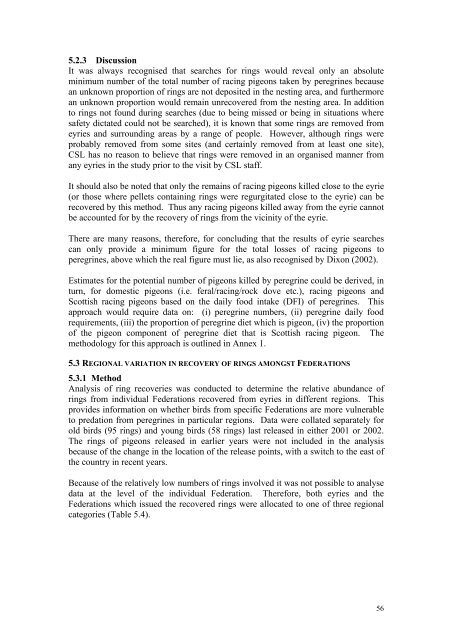RACING PIGEONS â IMPACT OF RAPTOR PREDATION
RACING PIGEONS â IMPACT OF RAPTOR PREDATION
RACING PIGEONS â IMPACT OF RAPTOR PREDATION
You also want an ePaper? Increase the reach of your titles
YUMPU automatically turns print PDFs into web optimized ePapers that Google loves.
5.2.3 Discussion<br />
It was always recognised that searches for rings would reveal only an absolute<br />
minimum number of the total number of racing pigeons taken by peregrines because<br />
an unknown proportion of rings are not deposited in the nesting area, and furthermore<br />
an unknown proportion would remain unrecovered from the nesting area. In addition<br />
to rings not found during searches (due to being missed or being in situations where<br />
safety dictated could not be searched), it is known that some rings are removed from<br />
eyries and surrounding areas by a range of people. However, although rings were<br />
probably removed from some sites (and certainly removed from at least one site),<br />
CSL has no reason to believe that rings were removed in an organised manner from<br />
any eyries in the study prior to the visit by CSL staff.<br />
It should also be noted that only the remains of racing pigeons killed close to the eyrie<br />
(or those where pellets containing rings were regurgitated close to the eyrie) can be<br />
recovered by this method. Thus any racing pigeons killed away from the eyrie cannot<br />
be accounted for by the recovery of rings from the vicinity of the eyrie.<br />
There are many reasons, therefore, for concluding that the results of eyrie searches<br />
can only provide a minimum figure for the total losses of racing pigeons to<br />
peregrines, above which the real figure must lie, as also recognised by Dixon (2002).<br />
Estimates for the potential number of pigeons killed by peregrine could be derived, in<br />
turn, for domestic pigeons (i.e. feral/racing/rock dove etc.), racing pigeons and<br />
Scottish racing pigeons based on the daily food intake (DFI) of peregrines. This<br />
approach would require data on: (i) peregrine numbers, (ii) peregrine daily food<br />
requirements, (iii) the proportion of peregrine diet which is pigeon, (iv) the proportion<br />
of the pigeon component of peregrine diet that is Scottish racing pigeon. The<br />
methodology for this approach is outlined in Annex 1.<br />
5.3 REGIONAL VARIATION IN RECOVERY <strong>OF</strong> RINGS AMONGST FEDERATIONS<br />
5.3.1 Method<br />
Analysis of ring recoveries was conducted to determine the relative abundance of<br />
rings from individual Federations recovered from eyries in different regions. This<br />
provides information on whether birds from specific Federations are more vulnerable<br />
to predation from peregrines in particular regions. Data were collated separately for<br />
old birds (95 rings) and young birds (58 rings) last released in either 2001 or 2002.<br />
The rings of pigeons released in earlier years were not included in the analysis<br />
because of the change in the location of the release points, with a switch to the east of<br />
the country in recent years.<br />
Because of the relatively low numbers of rings involved it was not possible to analyse<br />
data at the level of the individual Federation. Therefore, both eyries and the<br />
Federations which issued the recovered rings were allocated to one of three regional<br />
categories (Table 5.4).<br />
56
















